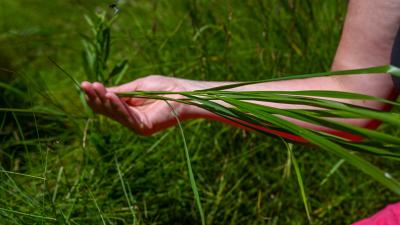
Photo by Peter Forbes
Wolankeyutomone kisi apaciyewik
Wolankeyutomone kisi apaciyewik, "Let us take good care of what has returned" Fund: The idea for Wolankeyutomone kisi apaciyewik comes from our Commission staff members' early engagement with other tribal land groups like The Native Land Conservancy and the Amuh Mutsun Land Trust to learn how they have been engaged with land return and what advice they would offer. One thing we learned was the fact that land back can come with many financial burdens that can continue to separate tribal members from the land. Members of First Light heard this insight during a listening session and a working group was formed to meet this need. Since most conservation groups factor “stewardship costs” into land acquisition to cover additional financial burdens, this was not new but this fund would need to be more flexible to serve indigenous land-relationships. This working group started by researching what other tribal nations are doing across the continent and found programs like Shuumi Land Tax, Real Rent Duwamish, Wiyot Honor Tax, and Mana-hatta Fund to learn how fundraising energy can support indigenous flourishing. While decisions about how to manage and implement the fund are ongoing, we wanted this section to inform people about the process. Here we describe how the fund was designed, specifically what types of monies were sought out for fundraising, how tribal citizens were engaged, and how the process of creating and maintaining the fund is designed to be separate from the Wabanaki Commission.
Wolankeyutomone kisi apaciyewik is a Passamaquoddy phrase that translates into "Let us take good care of what has returned". Here, Commissioner Darrell Newell pronounces the name of the fund in Passamaquoddy.
“Bring people together, celebrate the old ways, honor elders and the language keepers, teach traditional practices.”
Flexible Funding: The conservation world has taught us that often funds come with restrictions or stipulations for how they are to be used and these restrictions sometimes don’t allow for certain cultural practices, like cutting a tree versus harvesting a plant. We didn’t want that, so as members of First Light worked on this, they made sure to engage with funding sources that provided the most flexibility, that way ideas about Wabanaki relationships to the land could be explored by Wabanaki citizens in the ways that reflect their needs and priorities, not meeting the needs of funding criteria. With these parameters, the members of First Light set a goal to raise one million dollars as a startup for the fund. As we learned through this work, that one million can easily be spent on a land project if it has buildings that need updating or very little could be spent if it were for supporting purchasing equipment for a youth program. We needed to understand how to allocate these funds so we designed a process to engage with tribal citizens directly to learn how that should be done.
“In the past, all the funding the Tribes have gotten is for short-term economic fixes. This fund should be focused on long term cultural fixes.”
Engaging with tribal citizens: The goal for engaging tribal citizens was to do a qualitative interview process with representation from each federally recognized tribe. Since the Wabanaki Commission is made up of representatives from each tribal nation, typically one harvester and one from tribal government, these representatives were able to make recommendations of who to contact and to help make that contact. They also made it a point to not just recommend people they knew or those “usual suspects,” or the ones who get interviewed and interviewed, but they made recommendations of individuals who would represent a diversity of opinions. In the Spring of 2023, John Banks and Lakotah Sanborn completed 27 interviews across all tribal nations, a feat done by traveling to each community and listening to people’s honest feedback and reactions to the questions they posed to shape a report of recommendations. To add another level of transparency, we also sent out an initial draft of these interview responses to communities to solicit further feedback on critiques or additions that could strengthen the report, which were added in. These recommendations provide insights into how they can be spent and how they should be managed.
Separating the process: From the outset, it was clear for this fund to be legitimate, the fund needed to be completed by outside parties and managed separately from the Commission. While Commission Staff, Darren, Suzanne, and Tony provided input into the report, it was completed by John Banks and Lokotah Sanborn to create that separation. Through this input a recommendation was made to create a future staff position to oversee the management of the fund and that each grant cycle would occur by recruiting tribal citizens to make decisions on how these funds can best serve tribal communities. It’s meant that the ideas from the report can guide these decisions but ultimately, the fund will continue to evolve to meet tribal citizens' needs.
